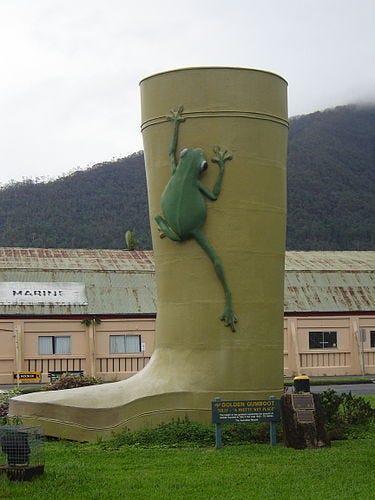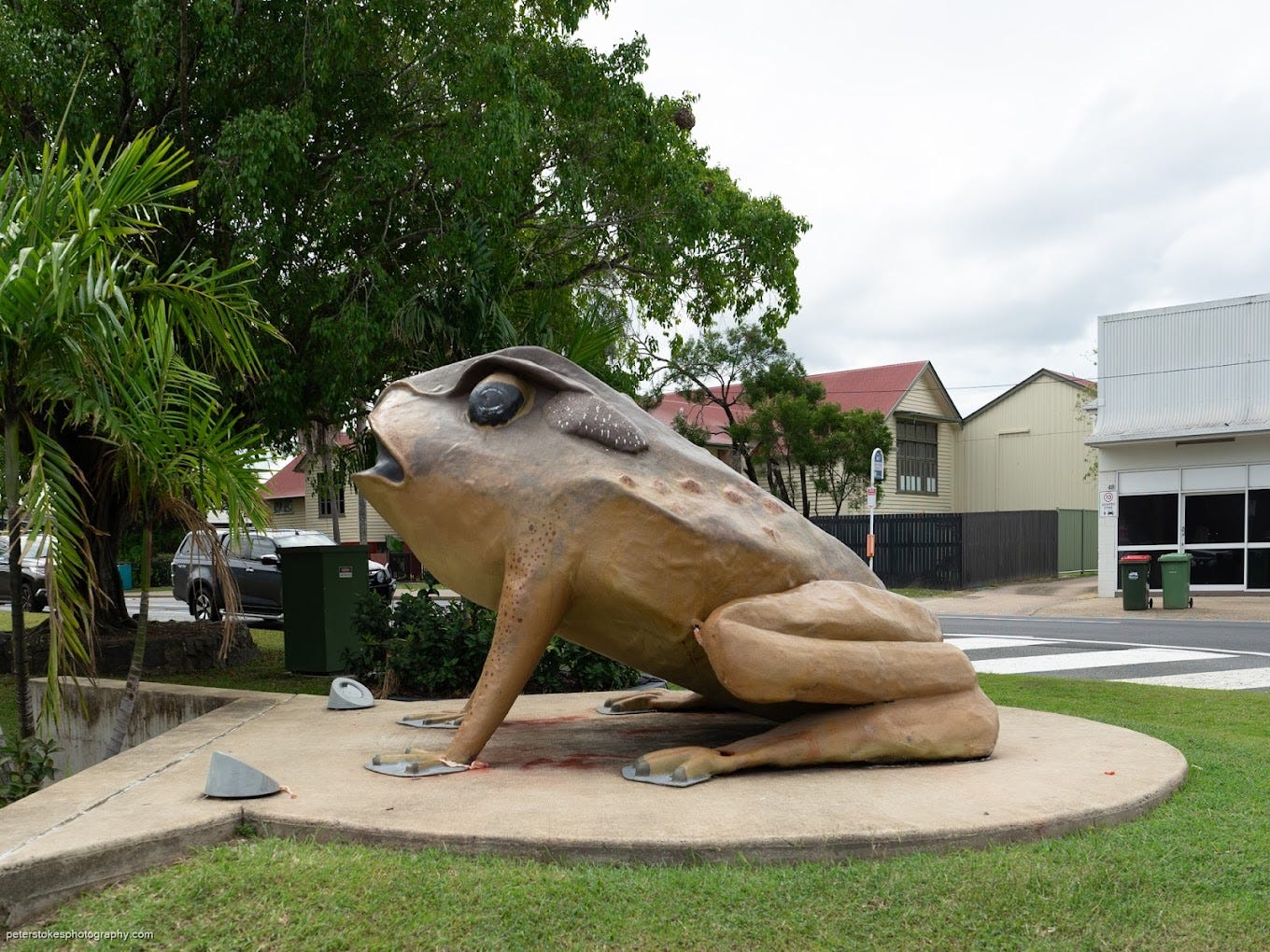Travelling – The Big Australian Road Trip – Queensland # 2
‘Someday we'll find it, that rainbow connection, the lovers, the dreamers and me’ – Kermit the frog
If you are enjoying our journey of BIGS, why not upgrade to a paid subscriber and go in the draw for a road map, to make navigation easier? The map is waiting for a winner. With your fortnightly BIG road newsletters you won't get lost. You'll be able to scratch off on the map, all the places you visit on the way and have the map as permanent memento. Why not frame it with a collage of your BIG snaps and you'll have a work of art, that will be a conversation starter for sure, as well as a constant reminder off your fun BIG road trip for years to come.
Just click on the link below, it costs less than a cup of coffee.
We’ve already clocked nearly 700 km, but today is a short leg - just 30 km down the road to Tully, home of the famous Golden Gumboot.
You might be wondering: why a gumboot?
Stay with me - it’s a great story.
If you read Big Australian Road Trip – Part One, you might remember me mentioning Tully in Queensland, where I had an unforgettable white-water rafting adventure - soaked to the bone, freezing cold, holding on for dear life, screaming, and loving every moment of it.
But back to the gumboot.
Since 1970, the towns of Babinda, Tully, and Innisfail have competed for the title of Australia’s wettest town. While Babinda often takes the crown for the highest average rainfall (around 4,279 mm per year), Tully has a record that’s hard to beat.
In 1950, Tully received a staggering 7,900 mm of rain—the highest annual rainfall ever recorded in a populated area in Australia.
To celebrate this soggy achievement, Tully built the Golden Gumboot in 2003. The boot is 7.9 metres tall, symbolising that record-breaking year. It’s made of fibreglass and sits proudly near the main street. You can even climb the spiral staircase inside for a great view of the town.
Perched on the side of the gumboot is a giant green tree frog—a fitting tribute to the local amphibians. The green tree frog, the largest of its kind in the world, can grow up to 110 mm, and females lay between 200 and 2,000 eggs each year.
Quick Facts About Tully
Tully is a major sugar-producing region with harvesting from June to mid-November.
The town is named after the Tully River, itself named in 1872 after William Alcock Tully, an important Queensland public official.
Before European settlement, the Djirbalngan and Girramay First Nations people lived in the area.
The gumboot statue was officially unveiled in June 2009, dedicated to Tully’s pioneers, particularly the Italian immigrants who helped build the local sugar and banana industries.
The Hearts Full of Hope book, which tells the stories of immigrants who shaped Tully, is available at the Tully Visitor & Heritage Centre.
The Tully Sugar Mill, owned by Chinese company COFCO since 2011, processes around 2 million tonnes of cane per year and offers tours.
Tully Hydro Power Station has been in operation since 1957.
From Frogs to Toads: Heading South to Sarina
Speaking of frogs, did you know that toads are technically a type of frog? All toads are frogs, but not all frogs are toads - confusing, right?
Let’s hit the Bruce Highway and travel 517 km south to Sarina, my childhood hometown, full of wonderful memories and friendly community spirit. Most locals worked in the sugar cane fields or at Power Alcohol (PA), where my dad worked. PA made the base for Vegemite, the iconic Aussie spread! Fun fact: my brother once dressed as a Vegemite jar for a school fancy dress ball—and yes, he won.
Sarina: Home of Buffy the Big Cane Toad
Sarina proudly hosts one of Australia's quirky "Big Things"—Buffy the Big Cane Toad.
I loved how the Land of the Bigs describes it:
"If you’re hitting the frog and toad (rhyming slang for 'road') on a trip up north, don’t forget to stop in Sarina to see this ample amphibian! At around one metre tall and wide, Buffy isn’t the biggest Big Thing, but she’s definitely one of the cutest."
Buffy started as a papier-mâché float in the 1983 Sarina Sugar Festival. She was such a hit that the community cast her in fibreglass and installed her in the main street. A "Name the Frog" competition in 1998 gave her the name Buffy - likely a nod to the cane toad’s former scientific name Bufo marinus, but perhaps also a cheeky reference to Buffy the Vampire Slayer, the TV show popular at the time.
Buffy got a makeover in 2016, was given a new platform to oversee the traffic, and now has a plaque honouring four of Sarina’s rugby league legends: Dale Shearer, Kevin Campion, Martin Bella and Wendell Sailor.
Buffy has been frog-napped several times over the years but always found her way back home. These days, she’s securely chained to her base, so please - only take photos, not souvenirs! Sadly, I couldn’t find any Buffy-themed magnets or t-shirts, which was a ‘tadpole’ disappointing.
Sarina is at the heart of Australia’s sugar cane industry. It’s a sweet little town with about 5,000 people, and just a short drive from Mackay, nestled between the beach and nearby mountains.
Trust me - you’ll be hopping mad if you don’t stop to meet Buffy!
The Cane Toad Story: Australia’s Infamous Pest
Cane toads were introduced to Australia in 1935 to control beetles in sugar cane crops. It was a spectacular failure. Instead of eating the pests, cane toads spread rapidly and became one of Australia’s most damaging invasive species.
Here are some fast facts:
Cane toads were imported from Hawaii, where they reportedly worked as pest control.
They failed to control beetles and instead poisoned native predators like quolls, goannas, and some snakes.
Many birds, such as crows, magpies, and ibis, have now adapted by safely eating cane toads using clever techniques to avoid their toxic glands.
Every stage of a cane toad’s life is poisonous—from eggs to adults, even when dead.
Cane toads can breed year-round, but prefer wet season conditions. Females can lay 8,000–30,000 eggs at a time.
Dettol can kill cane toads, but it’s a painful and controversial method.
Their toxic skin secretions, called bufotoxin, are dangerous to native animals, pets, and even humans.
Fighting Back: Taste Aversion Training
The Cane Toad Coalition and WWF-Australia are running taste aversion programs to help native predators survive the cane toad invasion.
By feeding small, non-lethal cane toads (or cane toad sausages) to native species, predators learn to associate cane toads with sickness and avoid eating them in the future. This method is showing promising results in the Kimberley region.
As Kermit the Frog once sang:
"Someday we’ll find it—the rainbow connection, the lovers, the dreamers, and me."
Hopefully, someday we’ll also find a solution to the cane toad problem in Australia.
Your Turn
Have you encountered cane toads on your travels? Do you have any funny (or not-so-funny) stories to share? And can you imagine 7,900 mm of rain in one year? I think you’d need more than a golden gumboot for that!
I’d love to hear your cane toad stories - let’s chat about this infamous Aussie pest and keep the conversation hopping.
Stay tuned for more of our BIG journey south through Queensland!






